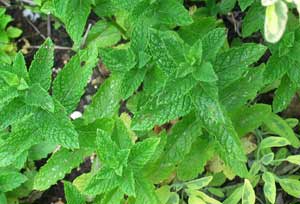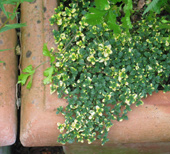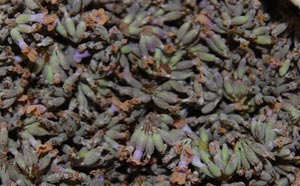Easy Herbs for Your Garden or Yard

Here are some easy herbs to grow at home. Most will happily thrive in the average garden in temperate areas of the world.
First, lets look at parsley, sage, rosemary and thyme. I'm sure they feature in the well-known song for a very good reason; they are top herbs to grow and deserve a place in any garden. They are also very straightforward herbs to grow at home from seedlings or cuttings.
Parsley is a soft-stemmed annual which grows best from seed. The other three are perennials which can be grown from cuttings. You can buy any of these as small plants to grow on at most good garden centres, too.
Here are growing tips for parsley, then sage rosemary and thyme. Then there are a few more easy common herbs, listed alphabetically, with brief growing tips for successful crops.
Please also see Growing Herbs Indoors and Out for more general advice on growing herbs.
Parsley (Petroselinum hortense)
For easy herbs for growing at home, parsley is not a bad choice.
The main difficulty is that parsley is notorious for being slow to germinate. It can take three weeks to come up - or even longer. Patience and fresh seed should ensure good results.
Once you have your seedling crop, plant it out when it’s about 1-2 inches high.
Be careful not to let the roots become bare when you ease the seedlings out of their seed tray. They do not take well to drying out. Growing them in soil blocks or small cells will prevent these difficulties.
Keep them well watered. Once they have established themselves in the herb garden they require no special help. If they tend to run to seed, just cut their heads off. You can also grow them in pots but you need to buy reasonably deep ones as they develop long tap roots.
If you want parsley available right through winter it is a good idea to start more seeds off in summer or autumn. At the end of the growing season let one or two plants run to seed and you will have plenty of seed to start again.
Even easier, just let them seed without hindrance and you will have dozens of new plants in the spring with no trouble at all! (You may even end up weeding them out as a weed crop.) Obviously, this method can be a bit hit and miss compared to sowing using a carefully-watched seed tray.
If you prefer, flat-leafed parsley is a good choice as it is easier to germinate. It also self-seeds abundantly and has a lovely fresh taste in cooked dishes and salads. It doesn’t taste quite like curly leafed parsley, though so you won’t get that traditional taste when you cook fish pie with parsley!
Parsley will grow indoors for short periods of time. I've not tried to grow it from seed indoors, through to maturity.
Sage (Salvia officinalis)
A sage bush is a valuable addition to any herb garden. They can grow quite large and sprawling, so put them towards the back of your herb collection and prune them in summer. A sheltered position in the sun is best. Sage keeps going all year round, hence the traditional turkey stuffing at Christmas.
Sage does not set seed well, so buy one from a good garden centre and when it is mature, take cuttings to produce new plants. Purple sage is good and you can find some other colours as well as the traditional grey-green leaved varieties.
Sage can be nice chopped finely in salad. Even if you aren’t keen on the strong, rather medicinal taste, a sage tea is great for sore throats as a gargle. The flowers are quite striking with their blue spikes and they are an absolute magnet for bees.
Growing herbs indoors? Sage is a fairly large plant which might manage in a container if you can provide cool conditions. I've not tried this yet.
Rosemary (Rosmarinus officinale)
Rosemary is another absolute must for any garden and it is definitely one of the easy herbs for most soil conditions. It yields a delicious, aromatic herb which transforms a plain meat dish into something special. It also has a place in vegetarian dishes and is very good with homemade oven chips and other potato dishes.
This woody shrub is probably a bit too large for the average herb garden, so plant it anywhere you would plant a medium sized shrub. It grows about a metre tall and can spread out quite a lot too. You can prune it to keep it in bounds of course. Even if you have only a tiny garden, it creates a stylish and attractive display.
Again, it is not one to grow from seed. It is easiest to buy one, or beg a cutting from a friend to start. It is another sun loving herb but is pretty hardy and will be available all winter long for those delicious winter stews and roasts.
As regards growing herbs indoors, this is not an easy one. You need a large planter and a good, light and airy space available. For most people, this is one to keep outdoors if you can.
See How to grow rosemary for easy planting and growing instructions.
Thyme (Thymus vulgaris)

Thyme is a pretty little miniature shrub, a bit like heather in size and shape. There are creeping varieties, too. The flowers are a beautiful lilac-blue and attract the bees.
Picture: Thyme does well in a planter
The leaves are available all year round, though there are more fresh green ones available in summer. It has a strong slightly medicinal scent as it contains thymol, an antiseptic much used in medicine.
You can grow thyme in spring or you can grow it from seed. There are also other varieties available. Golden thyme is a pretty, variegated variety and lemon-scented thyme is a good choice.
For growing herbs indoors, thyme is quite a good choice if you have the patience to go through the softening up process. This is a kind of reverse hardening-off. Plant the thyme in a pot a few weeks before you are going to bring it indoors. When it is happily growing in its pot, start increasing the amount of shade. This gets it used to growing in reduced light levels. After a week or two of lower light, bring it inside for a period each day, gradually lengthening the time spent indoors.
If you do this, you are more likely to have success with growing herbs indoors.
Thyme can be used in moderation in soups and stews and it can add a clean, fresh edge to salads. Moderation is the key, as the taste is quite powerful.
Thyme is one of the easy herbs once you have it established.
Basil (Ocimum basilicum)
If you like tomatoes you will want to grow basil. It is not quite as easy as most of the other common herbs, (at least here, in northern Europe) but it is just so wonderful it’s worth the effort. It is a soft and tender annual plant which may become a little shrubby in hot, dry summers.
Sow it on a windowsill once the day time temperature is reliable, say in May or the end of April. Keep the seeds moist and covered until the first seedlings appear. Prick out and grow on in roomier quarters as soon as you can. Small pots or a deeper tray will do for this. Punnets from supermarket fruit also make good seedling nurseries.
Be careful to hold these tender plants by the leaves when transplanting them, never the stem.
Make sure that there is no danger of frost before you put them out into their beds. They grow well with tomatoes and may help deter some insects as they are quite aromatic. Although basil is not such an easy to grow herb, its superb flavour and role as a companion plant make it a must!
Basil is a relatively easy herb to grow indoors to maturity. You just need enough warmth and light. You can also grow it as a seedling crop - straight from the seed sprouter to the table.
If you are growing herbs indoors, always check for signs of aphids. In my experience aphids can be more of a problem indoors than out as you have none of the natural predators to help your cause.
Lavender

Picture: Lavender is easy outdoors and the dried flowers are wonderful for potpourri
Lavender is easy to grow outdoors if your climate is not too cold. It is a plant with many uses, including some culinary ones!
The flower heads can be dried and used for scenting drawers and for potpourri.
The scent in the garden is divine and bumble bees are very happily employed amongst its flowers. It can get a bit straggly, so a good trim from time to time is required.
Lavender is an easy herb to find in garden centres and there are many beautiful varieties available.
Lovage (Levisticum officinale)
If you have room, try this dramatic plant. It is excellent for flavouring soups and stews. The taste is quite strong, so it is well to be stingy with it. It can grow to more than two metres tall in the right conditions. Once established, it should return year after year.
The seeds are also useful.
Establish new plants from seed, or by dividing the root in spring.
I've not tried growing it indoors as it is a bit big, to say the least.
Marjoram (Origanum)
Marjoram, or oregano, is another Mediterranean herb that grows quite well in more northerly climates. It can be sensitive to cold, so you may need to cultivate it as an annual, depending on where you live.
Here, in the south of England, it has almost taken on the status of a weed in my garden! It appears in new areas of the garden so it must be spread by wind or birds. I try to accommodate it as much as possible as it is such a good flower for the bees.
You can also propagate it by dividing the plant.
It is a great herb, with many uses, and in the garden the bees find it irresistible. The flowers can also be used for cutting for indoor displays.
There are small varieties available if you are short of space, or want to try growing it indoors.
Sweet marjoram (Origanum majorana) can be sown indoors and planted out after any frosts have finished.
Mints (Mentha)
There are many different mints available, so it’s nice to experiment with a few of the less common ones, such as pineapple mint or ginger mint. It is an exceptionally easy herb to grow as long as conditions are not too dry.
Mint is a hardy perennial, so you need to buy or be given a plant to start you off.
Once in the soil, this herb is an absolute thug, so you may want to pen it in by planting it in a large planter, or in a bed dedicated to it. Another way is to sink a large plant pot into the soil and plant it in there. It can escape even this if you’re not watching it carefully!
Mint has such a wonderful smell and so many culinary uses that I don’t mind its predatory behaviour as long as it stays in just a couple of sectors of the garden.
Use it in salads and to make cordials, tea, mint sauce … the list goes on.
It is very easy to grow – just try stopping it! It likes moist fertile soil but will manage practically anywhere. You can grow it quite easily in pots provided that you water frequently; you can bring a pot or two inside to extend the growing season into winter. It's also quite easy to dry for winter use.
If you have room for only one mint, peppermint (Mintha piperita) is probably the way to go.
Mint can be brought indoors for the winter but it is not the best of herbs for growing indoors. You will extend its useful life but it will still probably die off in the middle of winter. You can also bring it inside in early spring to get an early crop of new shoots and leaves.
For growing herbs indoors it is important to give plants time to acclimatise to the warmer, drier conditions of a house.
Tarragon (Artemisia dracunculus)
Tarragon is a versatile herb which is also very easy to grow. The easiest way to start is to divide a bit of root from a well-established plant.
Alternatively, you can take cuttings or just buy a young plant. Give it a fair amount of room as it likes to spread.
Tarragon grows each spring and disappears in winter as it is perennial. The best pickings are from the tips of the plant. The flavour develops as the summer progresses - it may be rather bland in spring.
You can use it in almost any dish but it goes especially well in egg dishes, with white fish and with chicken. It has a mild but distinctive flavour and can be used instead of basil in many recipes. Try it in omelets and flans. It is also excellent raw in salads.
You can also steep it in vinegar for year-round use.
Tarragon can also be dried in paper bags for winter use, or frozen in freezer bags or ice-cubes. Freezing it is probably the easiest method. It keeps its flavour quite well that way. There are two common varieties: French and Russian. French is far better for culinary use.
It is not especially suited to indoor herb growing as it is a tall plant which likes a sunny, sheltered spot. I've not yet tried growing it in a container.
If you are keen on growing herbs indoors and have the space in a sunny conservatory, for example, this might be one to try.
See Drying Fresh Herbs from Your Garden for more on drying methods.
Advertisements
Easy Herbs for Your Garden or Yard - TOP
Grow Food - How to Grow a Vegetable Garden
| Tweet |

| Tweet |

Footprints
- an occasional e-zine from Greenfootsteps
If you would like to receive the e-zine, please just sign up below.






New! Comments
Have your say about what you just read! Leave me a comment in the box below.